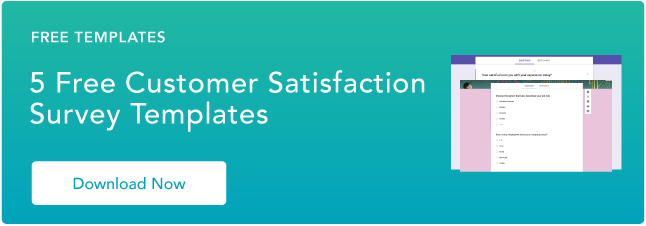Your survey response rate gives you a comprehensive glimpse into how customers perceive your survey. The higher the response rate, the better your survey is doing. If it's low, you'll know you must make some changes to improve effectiveness.
I'll explain everything you need to know about survey response rates, including what this metric is, how to calculate it, and some handy tips for improving it. (Spoiler: It's not as difficult as it seems.)
What is survey response rate?
Your survey response rate references the percentage of people who completed the survey compared to the number of people who viewed or started it. It's a metric that helps you determine whether or not a survey successfully engages its target audience.
Survey response rates primarily depend on what your team considers to be a "view." For example, if you're distributing your survey to a preset sample size, then you'll know exactly the percentage of people who complete it.
However, websites have made surveys more accessible and robust than your typical mail-in, multiple-choice form. Now, you can trigger a survey based on customer behavior or data stored in your CRM. You can now get your survey in front of more eyes than ever before, so you'll need to track these interactions carefully if you want to accurately calculate your response rate.
One option you can consider is customer feedback software, as many of these tools will have tracking codes and analytics that can record visits to your survey. Nevertheless, once you have determined how to record views, you can calculate your survey's response rate.
How to Calculate Survey Response Rate
The response rate can be calculated by dividing the number of completed survey responses by the number of people who viewed or started the survey. To convert this to a percentage, multiply your final number by 100.
Survey Response Rate Example
In this example, let's say 250 people viewed your survey, and 150 people completed it. In this case, your survey's response rate would be 60% (150/250 = .6 x 100 = 60%).

What Is a Good Survey Response Rate?
According to Startquestion, the average survey response rate is 33%. This number is a cumulative average taken from response rates recorded for different types of surveys. Startquestion also notes that the type of survey with the highest response rate is in-person surveys at 57%.
It's important to note that these numbers represent an average response rate for surveys — not the desired response rate. This means that your team should be striving to exceed these numbers when creating and distributing your own feedback forms.
If you're not meeting those benchmarks, I've rounded up some tips to help you improve your survey response rate.
Tips for Improving Your Survey's Response Rates
Ready to improve your survey response rate? Here are some of my favorite — and most foolproof — tips.
1. Reconsider what triggers your survey.
Timing is one of the most important variables to consider when you're managing a survey. If you're trying to get customers to answer questions on the fly, you need to pick the right times where they'll be most likely to lend a hand.
One of the best times to launch a survey is after a purchase. Sending a brief feedback form via email is a simple and easy way to engage customers after this key moment of delight. You can also send a survey after customer service interactions. Surveys like NPS and CSAT are great indicators of customer satisfaction and churn.
2. Shorten your surveys.
Arguably the most common reason that surveys have low response rates is that they're too long. Research from SurveyMonkey shows that abandonment rates increase by up to 20% once your survey takes longer than seven minutes to complete. The graph below can give you an idea of how long it takes for customers to fill out a survey based on the number of questions included.
For more tips to improve your response rates, read about the ideal survey length.
3. Change your survey's tone and design
Another variable to consider is the layout of your survey. If you're using the wrong tone, design, or type of survey, your content may not resonate with your target audience.
You can test for the most effective survey design by incorporating multiple CTAs on your webpage. For example, this blog post has three different CTAs that link to the same piece of content (bonus points if you find all three). By linking multiple page elements to one survey, you can see which one is the most effective and use that layout moving forward.
4. Let people skip sensitive questions.
If your survey has sensitive questions, such as inquiries about income, allow respondents to skip the question. By making sensitive questions optional, you may not gather quite as much data — but you won't lose the folks who would otherwise abandon the survey over one question they're uncomfortable with answering. I think this is a worthy tradeoff.
5. Incentivize folks to respond to surveys.
Are you more willing to complete a survey for a brand that offers a 15% off next-purchase coupon, or one that offers nothing? I'll admit it — I'd rather complete the survey for a coupon than for nothing in return. By offering an incentive, you can gain traction with folks who otherwise would skip out on completing the survey.
6. Make sure your survey is mobile-friendly.
I know, I know — you're probably tired of hearing about how mobile optimization is crucial. But it's impossible to overemphasize how crucial mobile optimization is. If your survey isn't easy to access on mobile, you risk isolating a lot of potential respondents who would prefer to use their mobile devices.
Keep an Eye on Survey Response Rate
Now that you know why your survey response rate is so important, you know how crucial it is to monitor it and act appropriately if you notice it sinking. Happy surveying!
Editor's note: This post was originally published in August 2020 and has been updated for comprehensiveness.
.png?width=112&height=112&name=Image%20Hackathon%20%E2%80%93%20Horizontal%20(24).png)

.webp)

![16 best free online survey makers and tools [+ recommendations]](https://53.fs1.hubspotusercontent-na1.net/hubfs/53/free-online-survey-maker-1-20251028-2654831.webp)


![How to conduct survey analysis like a data pro [all my tips + secrets]](https://53.fs1.hubspotusercontent-na1.net/hubfs/53/survey-results-1-20241031-6355381.webp)
![Leading questions: What they are & why they matter [+ Examples]](https://53.fs1.hubspotusercontent-na1.net/hubfs/53/leading-questions-hero.webp)
![How long should a survey be? The ideal survey length [New data]](https://53.fs1.hubspotusercontent-na1.net/hubfs/53/how%20long%20should%20a%20survey%20be_featured.png)



